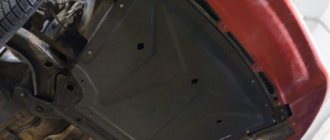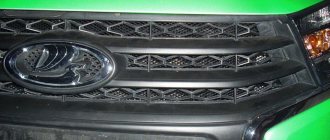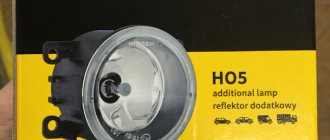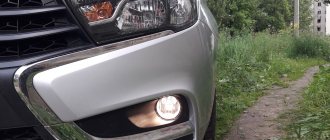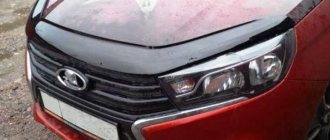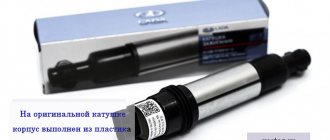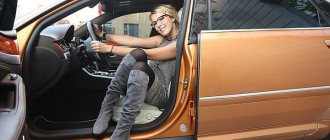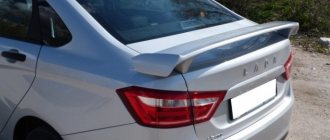Drivers feel quite confident behind the wheel of a Lada Vesta car. The only exception may be driving on some sections of “our” roads. Motorists' fears are well founded, because poor road surfaces can cause a broken engine crankcase, which will result in expensive repairs. Therefore, it is better to immediately think about which crankcase protection for the Lada Vesta engine will be optimal for traveling in your region.
Lada Vesta
What can cause crankcase damage?
The main enemy of protection is off-road conditions, potholes, bumps, and driving on rough terrain. If a sheet of iron comes into contact with the ground surface, the protection deforms.
The second problem is the car’s curb weight of 1300 kg. Hitting rocks and bumps at speeds over 60 km/h damages the metal surface of the armor.
The durability of the aluminum engine sump cover is several times lower than that of steel. Hitting a concrete curb at a speed of 45 km/h causes a crack in the oil pan.
Another important factor that must be taken into account when choosing and installing armor is metal fatigue of sheet steel and the negative impact of different environmental temperature conditions.
Related link:
Lada Vesta clutch.
Poor installation of the “sheet” can also cause damage to the oil pan. Loose fasteners sag, bolts break the aluminum pan cover, and engine oil leaks.
Installation procedure for the protective element
Like any other product, engine protection has instructions for use. Which you must carefully read before installation and strictly follow the advice of specialists.
Replacing or installing a protective element yourself is not a difficult job; any car enthusiast can do it if he wants. You will need a room equipped with a car lift or a repair pit; in extreme cases, you can use an overpass. It should be remembered that when using two jacks, it is necessary to install safety stops for safety. The standard shield is secured with thirteen bolts; dismantling requires a standard set of wrenches. Before installation, clean and lubricate all holes and screws. Repeat the steps in reverse order and tighten the screws tightly.
Everything is ready for use.
The need to install crankcase protection on Lada Vesta
Unlike European brands, which are designed for “ideal” roads, the engines of domestic VAZs need to be protected with a metal frame. The quality of the road surface in the periphery is very low, sometimes even non-existent.
In order to increase cross-country ability, engineers increased the ground clearance on the Lada Vesta to 171 mm. After installing 15-inch tires, you can count on a ground clearance of 174 mm.
With this level of ground clearance and pre-installed armor, the underbody of the vehicle is completely protected from damage.
Lada Vesta station wagon - How to repair a VAZ
Prospects for Lada Vesta station wagon
Today there is a lot of talk about AvtoVAZ’s new product – Lada Vesta. This model should go on sale any day now. A lot is known about the public, namely its characteristics, teasers, pictures, photographs flash here and there; photographs even of the Lada Vesta appear on the Internet, i.e. and there is plenty of information about the appearance of the car. However, everyone knows that global automakers do not focus on sedans and hatchbacks; they also like to release a more family-friendly option - a station wagon. For a very long time there were only rumors about the Lada Vesta station wagon, and word of mouth worked, but quite recently the president of AvtoVAZ made a statement in which he made it clear that work was also underway on the station wagon body. Again, based on indirect information, it became known that the public will see this car model at official dealers no earlier than 2022, and only if everything goes according to plan, and, as we know, economic plans do not always coincide with production plans.
Lada Vesta station wagon perspective
Appearance of the new Lada Vesta station wagon
The first photographs of this model have already appeared on the Internet, so we can already draw some conclusions and begin to discuss. Many will probably notice that the Lada Vesta station wagon combines already quite familiar features of cars from global manufacturers. So, for example, when examining the front of the car, you can discern some similarities with station wagons from 2000-2010.
In front of Lada Vesta station wagon
The front optics have a similar cut, a massive hood, and it seems that even its angle of inclination was chosen by Audi engineers. The front hood ends in a massive shape, which fits quite well into the overall exterior of the car. When you look at the Lada Vesta station wagon from the side, you can trace some features in its rear from Porsche.
Lada Vesta station wagon side view
The features of a German are especially visible in the slope of the luggage compartment lid. The designers have provided interesting lines on the sides that extend almost symmetrically from the front and back to the center. These body lines cause mixed opinions among critics and car enthusiasts. Some people really like them, but others may find them pretentious and unnecessary.
Lada Vesta design
In general, we can say that it turned out to be very beautiful and interesting. It is worth noting that the Lada Vesta station wagon model is another proof that the domestic auto industry has revised its vehicle equipment, and it should be noted that they have done it well.
The interior of the car, what can you see inside?
As already noted, at the moment there is only fragmentary information about the car. In this regard, talking about interior technologies and materials can only be a guess. It's likely to come with a host of built-in functions that can be controlled via the touchscreen display on the center console. An interesting thing is the dashboard, which will be made in a new concept for the plant. This will be a panel of several deep wells, which will have different lighting. These “wells” will be headed by a multimedia steering wheel. For the front passenger and driver, the company will install comfortable bucket seats, which are very comfortable and do not allow your back to get tired for a long time.
Lada Vesta interior design
Engine compartment of Lada Vesta station wagon
It is already said with almost complete certainty that under the hood of the Lada Vesta station wagon in the basic configuration you can see a gasoline power unit that squeezes out 87 horsepower. This engine was created by engineers of a domestic company. According to them, the engine has become quieter, more economical and more reliable than its previous versions. In tandem with this engine, the company’s employees will install a five-speed manual transmission.
Basic Lada Vesta engine
Anyone who thinks that 87 horses is not enough can buy themselves a Lada Vesta station wagon with a sixteen-valve engine. This unit allows you to get 106 horsepower at the wheels, which is already quite good. This motor was also designed and assembled at domestic factories. However, in addition to a five-speed manual transmission, this engine can also be paired with an automatic gearbox.
16 valve Lada Vesta engine
The latest option for filling the engine compartment is a power unit from Renault-Nissan. This engine is the most powerful in the series and produces 114 horsepower. To transmit torque to the wheels, the manufacturer installed a five-speed manual gearbox.
Motor from Renault-Nissan for Lada Vesta
It is worth noting that nothing is known yet about the dynamic characteristics, since the car has not been run-in or tested. The price is also not yet being considered, since it is not yet clear what will remain in the car from the above, and what will go down in history. It is hoped that the company's management will continue to pursue a competent pricing policy.
portalvaz.ru
Protection material
A number of materials are used in the manufacture of armor:
- high-strength steel for special geographic and climatic regions;
- steel;
- titanium;
- aluminum;
- stainless steel;
- composite materials.
Steel
This is the material that is used most often in the manufacture of protection. The thickness of the rolled material is 2 mm and reliably withstands impact, maintaining the integrity of the engine and gearbox at medium and low speeds.
Two-millimeter steel lends itself well to restoration during repair work. Low price is the main advantage of the material in comparison with analogues.
A disadvantage that cannot be prevented even by treating the bottom with mastic is rapid corrosion.
The average weight of the product is 8 – 12 kg, service life is 3 – 5 years depending on temperature conditions. Overall, a good combination of price and quality.
High strength steel
The design is similar to that described above, except that the thickness of the steel is increased to 3 - 4 mm. Massive sheets are installed extremely rarely on the Lada Vesta car; they are mainly mounted on jeeps, SUVs and SUVs.
Installing high-strength armor on a VAZ will not improve cross-country ability or other characteristics, but will provoke an increase in fuel consumption. The maintainability of the metal sheet is low due to its large thickness.
Related link:
How to remove the interior mirror on a Lada Vesta.
Aluminum
The thickness of the “winged metal” is 5 mm, but this does not affect the weight of the structure at all. The strength factor is not as high as steel (1.87), but still above average.
The absence of sparks upon impact and the low risk of fire are some of the main advantages of aluminum. The service life of the material is 5 – 7 years in the absence of mechanical damage.
Among the main disadvantages of aluminum protection are: the cost is 3–4 times higher than analogues, as well as rapid oxidation when interacting with oxygen.
Stainless steel
This type of metal will appeal to true connoisseurs of the presentable appearance of the part: the material has an increased shine. The strength coefficient is over 2.11%, the formation of rust and corrosion is excluded.
On Lada Vesta, such protection is installed during active use of the vehicle on the periphery, on the ground surface. The ground clearance is reduced from 171 mm to 164 mm. Before purchasing an accessory, consider the relevance of the part for your geographic region of operation.
The cost of protection is 3–4 times higher than analogues.
Titanium
The material's technical characteristics are several times stronger than steel and aluminum, and its weight is half that. The exorbitant cost of the accessory is a significant disadvantage among many advantages.
Composite materials
The materials used are polymers, fiberglass, carbon fiber. The manufacturing process consists of several stages: step-by-step application of layers of material, 5-6 in total. Resin is used to bind the layers.
Prices for finished products reach several thousand dollars. Perhaps this is the best offer on the market, if the price allows.
This material has many advantages: strength, flexibility of shape, resistance to temperature changes.
How to wash a car engine
In order to find out which product will best perform the washing function, it is necessary to study in advance the technical characteristics of certain products. For example, relatively old cars have an engine compartment that is not too densely filled. As a result, you can work in it only using bottles with a hand sprayer. Their design allows for precise dosing of detergent. This makes it possible not to spend a large amount of product when washing the power unit, which is better than washing a car engine with a bucket. New cars with tight engine compartments are treated with aerosols that penetrate even hard-to-reach places.
In specialized auto accessory stores you can purchase concentrated detergents that can be used to remove the most stubborn stains. It is worth remembering that when washing the engine, it is strictly forbidden to use products that contain acids or other chemicals.
Separately, it is worth noting that the use of gasoline or diesel fuel when washing the engine is strictly prohibited in order to avoid a fire.
Do-it-yourself oil pan protection installation on Lada Vesta
Preparation of the workplace, necessary tools
- rags;
- key, head at “13”;
- liquid for removing rust and corrosion WD – 40;
- flashlight to increase visibility area.
Related link:
Shock absorbers of Lada Vesta car
Regulations
- We hang the car with a hydraulic lift.
- Unscrew the eight screws to “13”.
- We omit the factory reservation.
- We install a new one, tighten the fasteners.
Review of Manufacturer Prices
| Serial number / protection article | Cost in rubles |
| AutoBronya (Russia) 1.06029.1 | From 1500 |
| Alfeco | From 1500 |
| Sheriff 27.2928 (Sheriff) | From 1700 |
| ABC-Design 28.20 | From 1500 |
| ABC-Design 39.01k | From 2000 |
| Novline-Autofamily NLZ.52.28.020 | From 800 |
| *prices are as of May 2022 | |
Conclusion
Is crankcase protection necessary - definitely yes, for residents of the periphery, where the quality of the road surface is far from ideal.
The process of independently installing crankcase protection on a Lada Vesta car is not complicated, but it requires increased attention and strict adherence to the regulations.
If you encounter difficulties during installation, contact a service station specialist. Car service workers recommend purchasing branded car armor and then installing it, because only the “original” guarantees compatibility with the body structure of your vehicle.
Possible consequences of the accident
Vesta's power unit sump is its weak point. After all, it is made from a fairly soft material and is not able to withstand impacts. Fortunately, if such an accident occurs in the city, there will be no problems calling a tow truck.
On our roads, a broken crankcase is not uncommon.
However, a broken crankcase will cause oil to leak from the engine. If the Vesta owner manages to immediately turn off the engine, most likely he will be able to get by with replacing only the crankcase, although this procedure is very expensive - purchasing new components and work will cost from 20,000 rubles. If it is not possible to immediately turn off the Lada engine, everything may end with a major overhaul of the power unit.
But an even more optimistic option involves obtaining a certificate from the traffic police (after all, this is internal damage), which means unnecessary red tape. In addition, the issue of the quality of the repairs carried out has also not been canceled. Even if all expenses are covered by the insurance company (if Vesta has CASCO insurance), next year insurance prices will be significantly increased.
After such an incident, the insurance company will probably increase prices.
However, things could be much worse. There have been cases when car owners have punctured the crankcase on the highway, far from the nearest city. In winter, in such a case, you will have to rely on the responsiveness of other drivers. The cause of an accident can be anything - from a pothole, to a piece of ice flying off a truck or a dropped load.
Pieces of asphalt can easily cause a broken crankcase.
Reviews
| № | Positive |
| 1 | Andrey (Avtodrom): I live in the city, the roads are good, I don’t need armor. |
| 2 | Sergey (Autotema): I bought metal protection, installed it myself, there’s nothing complicated about it. |
| 3 | Kirill (Autoreview): I’ve been driving a car with built-in armor for three years, no comments. I can’t say that the ground clearance has decreased significantly. |
| 4 | Alexey (Avtoria): a year has passed since the armor was installed, there are no comments, no creaks, no knocks. |
| 5 | Alexander (Drom): I’m happy with the purchase of protection, I often drive on the periphery, I don’t worry about the integrity of the engine. |
| 6 | Stanislav (Behind the wheel): the protection is good, practical, and does not deform. |
| 7 | Vasily Alekseevich (“5th wheel”): Three years have passed since installation, no complaints. |
| Negative | |
| 8 | Vitaly (Avtotema): the mount is not strong enough, sometimes it taps on uneven surfaces. |
| 9 | Svyatoslav (Otzovik.net): the price of original protection is unreasonably high. |
| 10 | Vlad (ProAuto): There are no particular complaints, but the quality of fastening can be improved. |
Lada Vesta station wagon | Blog-Mycar.ru
Prospects for Lada Vesta station wagon
Today there is a lot of talk about AvtoVAZ’s new product – Lada Vesta. This model should go on sale any day now. The public knows a lot about the sedan model, namely its characteristics, teasers, pictures, photographs flash here and there; photographs even of racing versions of the Lada Vesta appear on the Internet, i.e. and there is plenty of information about the appearance of the car. However, everyone knows that global automakers do not focus on sedans and hatchbacks; they also like to release a more family-friendly option - a station wagon. For a very long time there were only rumors about the Lada Vesta station wagon, and word of mouth worked, but quite recently the president of AvtoVAZ made a statement in which he made it clear that work was also underway on the station wagon body. Again, based on indirect information, it became known that the public will see this car model at official dealers no earlier than 2022, and only if everything goes according to plan, and, as we know, economic plans do not always coincide with production plans.
Lada Vesta station wagon perspective
Appearance of the new Lada Vesta station wagon
The first photographs of this model have already appeared on the Internet, so we can already draw some conclusions and begin to discuss. Many will probably notice that the Lada Vesta station wagon combines already quite familiar features of cars from global manufacturers. So, for example, when examining the front of the car, you can discern some similarities with station wagons from Audi produced in 2000-2010.
In front of Lada Vesta station wagon
The front optics have a similar cut, a massive hood, and it seems that even its angle of inclination was chosen by Audi engineers. The front hood ends in a massive radiator grille, which fits quite well into the overall exterior of the car. When you look at the Lada Vesta station wagon from the side, you can trace some features in its rear from Porsche.
Lada Vesta station wagon side view
The features of a German are especially visible in the slope of the luggage compartment lid. The designers have provided interesting lines on the sides that extend almost symmetrically from the front and back to the center. These body lines cause mixed opinions among critics and car enthusiasts. Some people really like them, but others may find them pretentious and unnecessary.
Lada Vesta design
In general, judging by the body, we can say that it turned out to be very beautiful and interesting. It is worth noting that the Lada Vesta station wagon model is another proof that the domestic auto industry has reconsidered its views on the design and equipment of cars, and it should be noted that they have done it well.
The interior of the car, what can you see inside?
As already noted, at the moment there is only fragmentary information about the car. In this regard, talking about interior technologies and materials can only be a guess. Most likely, this is a modern car interior with many built-in functions that can be controlled using the touch display on the center console. An interesting thing is the dashboard, which will be made in a new concept for the plant. This will be a panel of several deep wells, which will have different lighting. These “wells” will be headed by a multimedia steering wheel. For the front passenger and driver, the company will install comfortable bucket seats, which are very comfortable and do not allow your back to get tired for a long time.
Lada Vesta interior design
Engine compartment of Lada Vesta station wagon
It is already said with almost complete certainty that under the hood of the Lada Vesta station wagon in the basic configuration you can see a gasoline power unit that squeezes out 87 horsepower. This engine was created by engineers of a domestic company. According to them, the engine has become quieter, more economical and more reliable than its previous versions. In tandem with this engine, the company’s employees will install a five-speed manual transmission.
Basic Lada Vesta engine
Anyone who thinks that 87 horses is not enough can buy themselves a Lada Vesta station wagon with a sixteen-valve engine. This unit allows you to get 106 horsepower at the wheels, which is already quite good. This motor was also designed and assembled at domestic factories. However, in addition to a five-speed manual transmission, this engine can also be paired with an automatic gearbox.
16 valve Lada Vesta engine
The latest option for filling the engine compartment is a power unit from Renault-Nissan. This engine is the most powerful in the series and produces 114 horsepower. To transmit torque to the wheels, the manufacturer installed a five-speed manual gearbox.
Motor from Renault-Nissan for Lada Vesta
It is worth noting that nothing is known yet about the dynamic characteristics and fuel consumption, since the car has not been run-in or tested. The price is also not yet being considered, since it is not yet clear what will remain in the car from the above, and what will go down in history. It is hoped that the company's management will continue to pursue a competent pricing policy.
blog-mycar.ru
